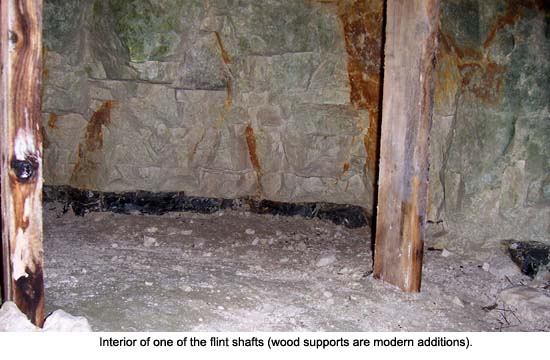Grime's Graves
by Richard Crowhurst
Hidden away in the depths of Thetford Forest in Norfolk, just off
the main A134 road between Kings Lynn and Thetford at Weeting,
are a series of pits and depressions known as Grime's Graves. In
total they cover an area of 90 acres. Despite their macabre name,
these pits originated, not as graves, but as mine shafts where
people dug for flint. The name came later, identifying the area
as the resting place of the Devil and associating it with Grim,
the ancient god of the underworld.

Back in the Neolithic Age, flint was a vital tool, highly
prized for its ability to take a razor sharp edge and its
durability. Concentrations of flint were a valuable natural
resource and this area of flint in the middle of Norfolk was
worked for nearly 1,000 years. During that time over 360 shafts
were dug at depths up to 30 feet. From these pits tunnels ran out
in different directions to form galleries where the best flints
could be mined. The flint nodules lay in three bands in the
softer chalk bedrock: the topstone, wallstone and floorstone. A
similar geological arrangement of linear flint streams can be
seen today in the chalk cliffs at Dunwich on the Suffolk
coast.
Today the site retains its atmosphere. Climbing down the narrow
steel ladder into one of the chambers, and then peering along the
low tunnels, it is easy to imagine the sounds of working and
chatter that would have filled the chambers. Walking across the
pits your feet are never more than inches away from scraps of
flint or worked stone. The ghosts of the past haunt the Breckland
landscape that, apart from the planting of the forest, has
changed little in millennia.
Each shaft and gallery was worked with tools of antler and bone
until the supply of flint in a particular hole began to dry up,
or the distance it needed to be dragged became too great. At this
time the shaft would be closed and a new pit dug. The spoil from
the excavations was put into a previously worked out hole, and
over the centuries this in-fill material slumped down to give the
area its current, distinctive, appearance. The pits would have
been wide with natural daylight filtering down to the working
floor. However, in the tunnels and galleries, illumination would
have come from primitive oil lamps with floating wicks. As well
as the deeper pits and galleries there is evidence of shallow,
opencast workings. These were only one or two meters deep as
people delved through the surface sand and mud to find the flints
lying in the chalk layer below.
Once excavated, and hauled to the surface by ropes or carried up
ladders, the flint would have been worked on site. So-called
knapping floors have been unearthed indicating the extent of this
enterprise. The flint nodules were carefully worked with
hammerstones to form axes and knives. Relatively few of these
artefacts have been uncovered in the local area indicating that
much of the flint may have been transported elsewhere in the form
of rough blanks. The fact that Grime's Graves lies close to the
ancient trackways of the Peddars Way and the Icknield Way would
have made transport of the flints straightforward. There is
evidence that the miners may have conducted ceremonies at the end
of their excavations and artefacts such as a crudely carved chalk
woman and flint nodules inscribed with pictures have been
found.
The first recorded excavation of the site occurred between 1868
and 1870, following similar excavations on the South Downs in
Sussex. Despite the size of the site in Norfolk, most of the
flint mining in ancient Britain occurred in the south. However
the pits at Grime's Graves are the best preserved, and the only
place it is possible to descend a ladder to see the ancient
workings.
Other Attractions in the Area
Oxburgh Hall is a moated Tudor manor house about half an
hour's drive away. A visit to Grime's Graves and Oxburgh can be
combined for a day out from a base elsewhere in East Anglia. The
house is owned by The National Trust. It features rooms charting
the development of domestic decorative fashion from medieval
times to Victorian neo-Gothic excess. There are attractive
gardens, a woodland walk and the family chapel to explore.
More Information:
We regret that we no longer have the resources to maintain up-to-date links and/or hours and pricing details for the various sites and attractions listed on this website. For more information about the location(s) listed above, please use your favorite search engine or visit Wikipedia.
Richard Crowhurst is a freelance writer and author based in Lincolshire,
England. He writes on many subjects, including history and heritage topics.
More details can be found on his websites, http://www.freelance-writer-and-author.co.uk and http://www.enagri.info.
Article © 2006 Richard Crowhurst
Photo courtesy of Wikipedia.org
| 